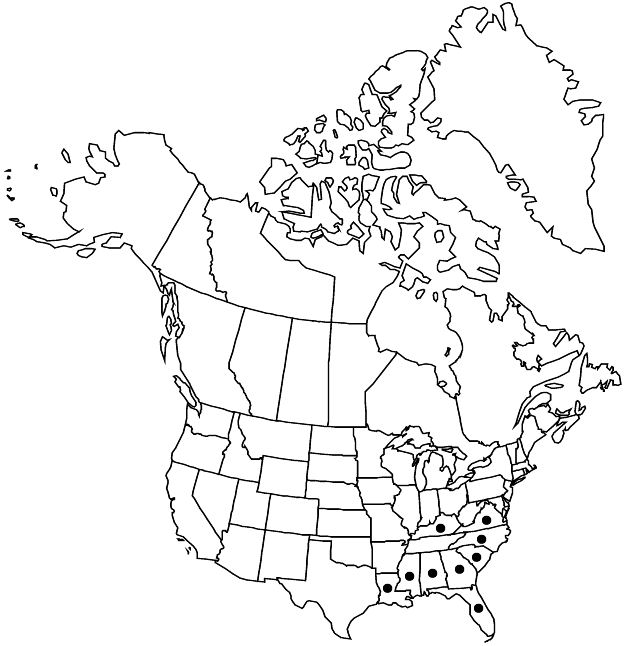Difference between revisions of "Cnidoscolus stimulosus"
Boston J. Nat. Hist. 5: 234. 1845.
FNA>Volume Importer |
FNA>Volume Importer |
||
| Line 25: | Line 25: | ||
|name=Bivonea stimulosa | |name=Bivonea stimulosa | ||
|authority=(Michaux) Rafinesque | |authority=(Michaux) Rafinesque | ||
| − | }}{{Treatment/ID/Synonym | + | }} {{Treatment/ID/Synonym |
|name=Cnidoscolus urens var. stimulosus | |name=Cnidoscolus urens var. stimulosus | ||
|authority=(Michaux) Govaerts | |authority=(Michaux) Govaerts | ||
| Line 43: | Line 43: | ||
|elevation=0–600 m. | |elevation=0–600 m. | ||
|distribution=Ala.;Fla.;Ga.;Ky.;La.;Miss.;N.C.;S.C.;Va. | |distribution=Ala.;Fla.;Ga.;Ky.;La.;Miss.;N.C.;S.C.;Va. | ||
| − | |discussion=<p>In Kentucky, Cnidoscolus stimulosus is occasionally naturalized along railroads. Although closely related to C. urens (Linnaeus) Arthur of Mexico, Central America, and South America, C. stimulosus differs in habit, leaf pubescence, and seed shape, and the two are treated here as distinct species.</p> | + | |discussion=<p>In Kentucky, <i>Cnidoscolus stimulosus</i> is occasionally naturalized along railroads. Although closely related to <i>C. urens</i> (Linnaeus) Arthur of Mexico, Central America, and South America, <i>C. stimulosus</i> differs in habit, leaf pubescence, and seed shape, and the two are treated here as distinct species.</p> |
|tables= | |tables= | ||
|references= | |references= | ||
| Line 67: | Line 67: | ||
|publication year=1845 | |publication year=1845 | ||
|special status=Weedy;Selected by author to be illustrated;Endemic | |special status=Weedy;Selected by author to be illustrated;Endemic | ||
| − | |source xml=https://jpend@bitbucket.org/aafc-mbb/fna-data-curation.git/src/ | + | |source xml=https://jpend@bitbucket.org/aafc-mbb/fna-data-curation.git/src/8f726806613d60c220dc4493de13607dd3150896/coarse_grained_fna_xml/V12/V12_1014.xml |
|genus=Cnidoscolus | |genus=Cnidoscolus | ||
|species=Cnidoscolus stimulosus | |species=Cnidoscolus stimulosus | ||
Revision as of 15:42, 18 September 2019
Plants 10–120 cm. Leaves: stipules 2–3.5 mm, margins entire; petiole 3–8 cm; blade ovate to round in outline, 5–17 × 4–12 cm, deeply lobed, lobes (1/2–)3/4–9/10 blade length, base broadly cordate to truncate, margins usually dentate, rarely entire, teeth and lobe apices acute to obtuse, not aristate. Staminate flowers: calyx salverform, tube 8–11 mm, distally straight or constricted, stinging hairs absent, lobes 7–10 mm; stamens of outer whorl shorter than inner, filaments of outer whorl distinct, of inner whorl connate most of length; staminodes 0. Pistillate flowers: sepals 10–15 mm; stigmas 12–24. Capsules 10–12 mm. Seeds brown, sometimes mottled, 8–9 mm. 2n = 36.
Phenology: Flowering Mar–Aug.
Habitat: Sandhills, dry sandy woods, sandy old fields.
Elevation: 0–600 m.
Distribution

Ala., Fla., Ga., Ky., La., Miss., N.C., S.C., Va.
Discussion
In Kentucky, Cnidoscolus stimulosus is occasionally naturalized along railroads. Although closely related to C. urens (Linnaeus) Arthur of Mexico, Central America, and South America, C. stimulosus differs in habit, leaf pubescence, and seed shape, and the two are treated here as distinct species.
Selected References
None.
